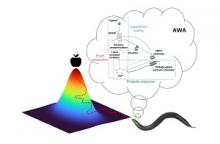- About us
- Research
- Students & Teaching
- Seminars & Events
- Directories
- Booking Rooms & Equipment
- עברית
Home » Prof. Alon Zaslaver - how many neurons do you need to calculate the derivative of a function?
A new study in the laboratory of Prof. Alon Zaslaver from the Department of Genetics at the Institute of Life Sciences shows that even a single neuron in the brain of a tiny (1 millimeter) worm, aka C. elegans, can do the job.
How?
The worm has no sense of sight, and therefore relies on the sense of smell to locate food sources. It will navigate towards a food source, for example a rotting fruit, based on the odors emitted from it. For this, the worm needs to assess the strength of the smell at the point where it is standing, move a short distance in a certain direction, and then assess the strength of the smell again. Subtracting the odor intensities between two nearby points (the derivative definition) allows it to infer how to proceed: A difference greater than zero (a positive derivative) means it is in the right direction, so proceed straight. Alternatively, if the derivative is negative, it is in the opposite direction, so turn around.
In fact, the Zaslaver group discovered that the worm is even more talented than that. Not only does it calculate small differences, it continuously searches in space for increasing positive derivatives, a strategy search that brings it much faster to the goal (a finding published in Nature Comm.).
Recently, the Zaslaver team revealed that this derivation is performed within a single neuron, and they even managed to crack the molecular mechanism that makes the complex calculation possible. It is based on an intracellular negative feedback that compares a newly calculates derivatives with the recent ones.
"The beauty of using a small and simple model animal like the worm is that a variety of sophisticated methods can be applied (e.g., genetic engineering and scanning brain-wide activity with unprecedented single-neuron resolution) to extract deep understanding of complex biological mechanisms," explains Prof. Zaslaver. "By scanning various mutants, we found the genes and proteins that participate in the cellular calculation. To prove that the calculation was done in a single neuron, we restored the activity of a defective gene exclusively in one target neuron, and the cell returned to perform its computational function. The fruitful collaboration between the members of the lab was a key factor for our success as it necessitated to combine expertise in molecular systems and complex experimental setups with mathematical modeling and simulations that aided us to interpret the experimental results."
The research, recently published in the scientific journal Molecular Systems Biology, was led by the students Rotem Ruach (now Dr. Ruach), and Shai Yellink (PhD student in the Neural Computational Program in Brain Sciences).
Read the papers:
